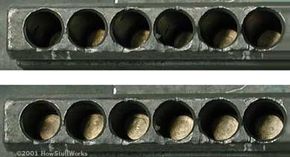Picking Pin-and-tumbler Locks
In the last section, we saw that the correct key will position the pins in a pin-and-tumbler lock so that all of the lower pins rest in the cylinder plug and all of the upper pins rest in the cylinder housing. To pick this sort of lock, you simply move each pin pair into the correct position, one by one.
There are two main elements involved in the picking process:
Advertisement
- Picks - Picks are long, thin pieces of metal that curve up at the end (like a dentist's pick). They are used to reach into the lock and push the pins up
- Tension wrench - Tension wrenches come in all shapes and sizes. Functionally, they aren't very complex. The simplest sort of tension wrench is a thin flathead screwdriver.
The first step in picking a lock is to insert the tension wrench into the keyhole and turn it in the same direction that you would turn the key. This turns the plug so that it is slightly offset from the housing around it. As you can see in the diagram below, this creates a slight ledge in the pin shafts.
While applying pressure on the plug, you insert a pick into the keyhole and begin lifting the pins. The object is to lift each pin pair up to the level at which the top pin moves completely into the housing, as if pushed by the correct key. When you do this while applying pressure with the tension wrench, you feel or hear a slight click when the pin falls into position. This is the sound of the upper pin falling into place on the ledge in the shaft. The ledge keeps the upper pin wedged in the housing, so it won't fall back down into the plug.
In this way, you move each pin pair into the correct position until all of the upper pins are pushed completely into the housing and all of the lower pins rest inside the plug. At this point, the plug rotates freely and you can open the lock.
Conceptually, the lock-picking process is quite simple, but it is a very difficult skill to master. Locksmiths have to learn exactly the right pressure to apply and what sounds to listen for. They also must hone their sense of touch to the point where they can feel the slight forces of the moving pins and plug. Additionally, they must learn to visualize all the pieces inside the lock. Successful lock picking depends on complete familiarity with the lock's design.
Another technique is raking. Raking is much less precise than actually picking. To rake a lock, you insert a pick with a wider tip all the way to the back of the plug. Then you pull the rake out quickly so that it bounces all of the pins up on its way out.
As the rake exits, you turn the plug with the tension wrench. As they're moving up and down, some of the upper pins will happen to fall on the ledge created by the turning plug. Often, locksmiths will start by raking the pins, and then pick any remaining pins individually.
We'll look at wafer-tumbler and tubular locks next.
